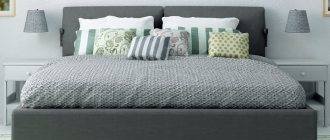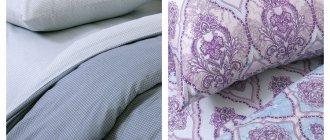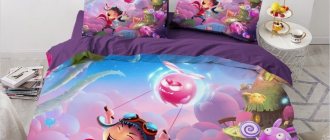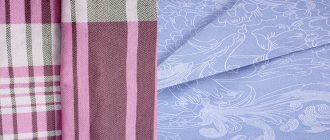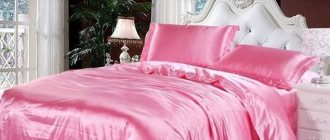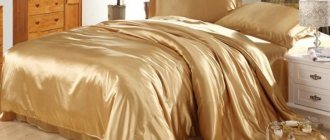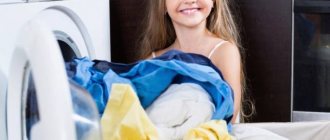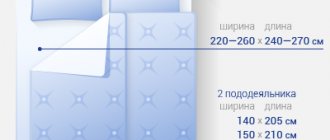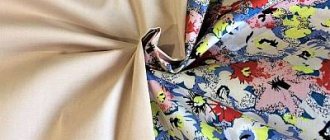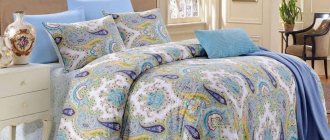History of fabric
The specific technology of percale weaving was first mastered in medieval India. Mass production of the material began at the end of the 17th century in French industrial manufactories. The fabric then had a technical purpose: additionally processed with oil or organic resin, it was used for the production of ship sails. At the dawn of aviation, the material impregnated with varnish began to be used to create parachutes and cover aircraft bodies. In the 70s of the 20th century, light camping tents were made from percale.
Photo source: Depositphotos.com
The introduction of thin threads into production brought the fabric into the sphere of household use: soft and durable percale home textiles quickly gained popularity.
Characteristics of percale for bed linen
In the 18th century in Europe, the finest fabric was woven specifically for royalty. The description of the material cannot be without epithets: “the most delicate sheets”, “silky surface”, “durable and reliable products”, “light, airy”...
In France, since time immemorial, fabric has been considered a symbol of refined taste, true elegance and beauty. The secret of percale lies in the natural properties of long-staple cotton, which was previously grown only in Egypt. Now new varieties with long fibers have been created, and the technology for processing plant raw materials has changed. Percale is no longer in short supply and is produced in many countries.
The material, woven from thin threads, due to the low fluffiness of the fiber, turns out to be quite dense, at the same time pleasant, smooth to the touch. Percale can be used for a long time and is easy to wash. The fabric is smooth and light. At the same time, it retains elasticity and has a large margin of tensile strength.
For reference. Animal hair and dust do not stick to percale. Thanks to these qualities, the canvas is used to make quilts and pillows. Fibers of padding polyester or wool do not penetrate through the fabric, even the smallest fluff remains inside.
White rolls are run through printing presses, and clear prints and patterns appear on the canvas. Printed paints do not fade or fade after washing.
Application
- The main area of application of percale is sewing luxury bedding sets. First-class percale linen ensures a comfortable, healthy sleep.
- Percale home textiles give comfort: bedspreads, tablecloths, decorative napkins.
- The material is used to sew pillow covers, mattress covers, and the top layer of blankets.
- Thin fabric is suitable for sewing wardrobe items: women's blouses, dresses, men's shirts.
- Technical percale is used in industry for sewing parachutes and awnings.
What density of percale is best for bed linen?
Many housewives have a question: what density of percale is best for bed linen ? The optimal percale density is 120 grams per square meter. meter, where there are from 85 to 120 linen thread intersections; in linear density it reaches up to 200 inches (TC).
Percale is very similar in texture to poplin. On the front side of the percale the print is very bright and shiny, while the back side is muted. The material is very smooth, wear-resistant, made from long cotton fibers that have a plain weave, this is the most important proof that you can determine which bed linen is better than poplin or calico, or percale. The fibers are not twisted with threads of the same length, which help withstand a large number of washes. Doesn't wear out, handles heat well and is very smooth.
Due to special processing of the threads, it creates a protective layer against the formation of pills, puffs, and strong creases. PBC is also made for the little ones who have lung problems or allergies. Therefore, it is hypoallergenic and has no static electricity.
Description of the fabric: composition, properties, characteristics
Classic percale is a material made from long-staple combed cotton. The fabric is smooth, soft and delicate to the touch, surprisingly pleasant to the body. It retains heat, allows air to pass through, allowing the body to breathe, absorbs moisture, and does not accumulate static electricity.
The threads of the fabric fit tightly to each other, the percale does not show through. The linear density of the fabric ranges from 90 to 160 threads per 1 cm². Surface density is 72-150 g/m2 depending on the type of material.
What is the difference between percale and calico
Now let's compare it with calico. This is the simplest version of cotton material, which uses plain weaving, which is also typical for percale. However, calico is rougher to the touch and is perceived as rougher. It is also heavier, although it also allows air to pass through, and the price is much cheaper. Both bedding is hygienic and hypoallergenic, but only percale sets will definitely last longer. The choice again is yours. The main thing is that you like the purchase and contribute to excellent sleep!
In the video you can see more information about this material:
Types of fabric
Fabric is classified by composition:
- cotton percale;
- percale with added flax;
- material with polyester additives;
- percale with added silk.
Depending on the purpose, the material is divided into:
- household - intended for home use;
- technical - has a special purpose, used in industry.
Advantages and disadvantages
Percale has a myriad of advantages, among which it is worth noting:
- strength;
- softness;
- long service life: sets of linen can be used for up to 10-15 years;
- wear resistance: the fabric does not deform, does not fade in the sun, does not fade, and is not subject to pilling;
- pleasant tactile sensations and aesthetic appearance;
- saturation, color fastness;
- hygiene, comfort in use: the material is characterized by hygroscopicity, heat-saving properties, and breathability;
- impermeability: does not allow down and feathers to escape, maintains the integrity of the stuffing.
The disadvantages of the fabric include:
- shrinkage is possible within 3%;
- The components of the dressing can cause allergic reactions on sensitive skin.
Comparison of cotton bedding from different materials
PCB made from different fabrics with similar characteristics in approximately the same price range will have, albeit minor, differences:
| Percale (100% cotton) | Poplin (100% cotton) | Satin (100% cotton) | Calico (100% cotton) | Ranfors (100% cotton) |
| Density | ||||
| 130-150 g/m | 120-150 g/m | 100-140 g/m | 100-150 g/m | 120-140g/m |
| Hypoallergenic | ||||
| — | + | + | + | + |
| Environmental friendliness | ||||
| + | + | + | + | + |
| Hygroscopicity | ||||
| + | + | + | + | + |
| Wear resistance | ||||
| + | + | + | + | + |
| Easy to care for | ||||
| + | + | + | + | + |
| Tactile sensations | ||||
| Softness, thinness, smoothness | Softness, velvety | Softness, tenderness | Sufficient rigidity and density | Softness, silkiness |
| Visual features | ||||
| Velvety, matte surface | Smooth, silky surface | Glossy shine, smoothness | Smooth, matte surface | Silky shine, smooth surface |
| average price | ||||
| 2300 | 1500 | 2500 | 1500 | 2500 |
The main characteristics of popular fabrics of identical composition are similar. The differences are mainly in tactile and visual features. Let's find out what is better: calico, poplin, satin or percale.
Satin is ideal for those who appreciate external gloss, shine and some pretentiousness.
Ranfors will be appreciated by lovers of refined simplicity and comfort.
Due to its long service life, poplin will be preferred by supporters of practicality, and calico will be preferred by lovers of classic starched sheets, since, unlike other cotton fabrics, calico is a bit harsh.
Percale feels noticeably softer than calico, but harder than satin.
In terms of cost, bed linen made from percale is cheaper than similar sets made from ranfors and satin, and almost one and a half times more expensive than from poplin and calico.
Tips for choosing
There can be no clear recommendations for choosing one material over another - the choice depends on individual preferences and financial capabilities.
Ideally, it would be great to purchase different kits and compare them yourself during use.
Percale has a number of undoubted advantages:
- wear resistance. High fabric strength ensures long use;
- uniformity - due to the tight fit of the threads to each other;
- environmental friendliness - subject to the use of natural materials;
- ease of care - easy to wash and does not require ironing;
- color fastness - the fabric does not fade;
- is not afraid of direct sunlight, the design does not fade in the sun;
- hygroscopicity - absorbs moisture while remaining dry;
- holds its shape perfectly, does not deform, retains its original appearance throughout the long process of operation;
- almost does not shrink - shrinks during operation no more than 3%;
- “pellets” do not form on the surface;
- pleasant to the touch;
- the high density of the fabric does not allow the filling of the pillow and blanket to come out.
Percale fabric however has disadvantages:
- allergenicity. To ensure complete objectivity, it is worth noting that even percale made from 100% cotton cannot be considered an absolutely hypoallergenic material. Components in the dressing, although extremely rare, can cause a reaction or irritation;
- made from a polyester-blend fabric may cause excessive sweating. Natural canvas does not have this drawback.
- percale wrinkles a lot, which, in particular, differs from poplin.
Percale and its analogues
The percale material is similar in composition and consumer properties to poplin, satin and calico.
- Percale linen is a leader among its peers in terms of wear resistance and strength.
- Compared to satin, percale is harder, less smooth, and does not shine at all. Satin wins in visual appeal, but percale is more breathable, shape- and color-resistant, and wicks away moisture better.
- Compared to poplin, percale is denser and rougher to the touch. A clear advantage of percale is its low wrinkleability, while poplin requires ironing after each wash. In other characteristics, the fabrics are as similar as possible.
- Compared to coarse, rough-feeling calico, percale is famous for its smoothness, delicacy and softness, and has less weight and greater density. In other properties, high-quality calico is quite comparable to percale and successfully competes with it.
Comparison of percale with poplin and satin
It is impossible to confuse satin and percale, knowing their differences. The first type of fabric has a glossy surface, while the second has a more matte surface. Shades on satin are more saturated. Most consumers believe that this material looks more aesthetically pleasing.
Percale wrinkles much more than satin, which practically does not have this drawback. The latter material is softer to the touch.
Satin has less breathability and can be uncomfortable on hot days. The fabric is less durable, and from frequent washing it begins to shine, become thinner, and wear out.
Percale and poplin have fewer differences. The first option is much more durable and wear-resistant than the second. Unlike percale, poplin has no back and front sides. It is identical on both sides. The fabric is soft, pleasant to the touch, but less smooth.
Watch the comparison video review:
Care instructions
Percale is an easy-care fabric, but to maintain its attractiveness and unique properties it requires care and compliance with the manufacturer's recommendations.
General rules:
- The first wash is done in water at 30-45 degrees to maintain brightness and color saturation.
- For subsequent washes, temperatures up to 80 degrees are permissible. Linen should not be pre-soaked or boiled.
- Machine washable with spin speed up to 800 rpm. White linen is washed separately from colored linen. It is recommended to turn items inside out before washing.
- Do not use chlorine bleach; mild detergents are recommended. To soften hard water you need a conditioner.
- Dry percale products naturally, by hanging them and spreading them well on ropes or a special dryer.
- The optimal iron temperature for ironing is no higher than 150 degrees.
How to wash
On the Internet you can only rarely find negative reviews regarding this fabric. Women write that percale for bed linen does not tolerate washing well and wears out instantly. Mostly, such comments are left by people who encountered a low-quality fake or did not provide the items with proper care.
In order to use the product for as long as possible and maintain its impressive appearance, you must follow the manufacturer’s simple recommendations for caring for it. You need to pay special attention to the washing process.
Despite the fact that the material is quite durable and unpretentious, it still needs to be protected during washing: fasten zippers and buttons, turn duvet covers and pillowcases to the wrong side, especially if they have a printed pattern. Then it can be easily washed and can withstand more than 1000 cycles.
Before first use, percale bed linen is rinsed in water, the temperature of which should not exceed 30 0C.
Subsequent washes are carried out according to the following rules:
- washing is carried out using soft, non-abrasive, preferably liquid, detergents;
- It is recommended to use softeners and conditioners;
- It is strictly forbidden to add bleaches that damage the fibers;
- the optimal washing temperature is 450C, but sometimes it can be increased to 600C;
- Spin at low speed.
The manufacturer does not recommend soaking, starching or boiling the product.
After the first wash, slight shrinkage is possible (no more than 2%). Afterwards the form will not change.
A stale set should not wait too long to be washed. It is better to store dirty items in special plastic containers in well-ventilated areas.
The freshness and aroma of clean linen will last longer if you store it in a tightly closed closet.
Percale linen is also demanding and capricious when it comes to ironing: it needs to be ironed only from the wrong side, not exceeding 150 degrees. You should not leave the iron in one place for a long time - the fabric will become deformed due to overheating.
Recommendations for use
There are many low-quality fakes of percale on the textile market. To avoid disappointment, you need to carefully examine the fabric before purchasing.
- The percale weave is dense, in no way cross-shaped or circular, the fibers seem to be glued to each other.
- The fabric is dense, does not shine through, and is evenly dyed on the front and back sides.
- If possible, you can conduct a combustion test: it will help identify fake synthetics. A material with a predominance of cotton burns with a bright flame, spreading the smell of burnt paper around, and after extinction it smolders, forming ash. When polyester dominates, the fabric melts, spreading black smoke and a pungent odor, and bakes into a dense lump.
Manufacturers and brands
The material is produced by factories in Italy, Spain, France, England, Portugal, and Poland.
In Europe, percale is extremely valued and is called the royal fabric.
Among Asian countries, China, India, and Pakistan are famous for the production of percale.
Russian manufacturers are not lagging behind foreign ones. On an industrial scale, percale is produced at enterprises in the city of Ivanovo and the Ivanovo region, as well as at the famous Moscow Trekhgornaya manufactory.
Reviews of percale fabric
Percale receives a large number of positive reviews every day. Users cite the strength, durability, softness and beauty of fabric products as undoubted advantages. Buyers note the high cost of percale linen sets, but admit that the quality of the material speaks for itself; percale is definitely worth the money spent.
Owners are advised to pay attention to the capricious behavior of the fabric in care, to be especially careful when washing for the first time: incorrect actions lead to damage to things.
Percale is the queen of linen fabrics, it is a symbol of prestige, good wealth, gives pleasure, and attracts with the beauty of its appearance. A wide range of colors allows you to satisfy even the strictest personal preferences and enrich any interior.
Percale compared to other fabrics
It’s difficult to immediately see the difference between similar cotton fabrics with different names if you haven’t “eaten the dog” in this matter. But if you look closely, and even more so if you use the products, you can understand how they are similar to each other and how they differ.
Percale and poplin
The fabrics are similar at first glance. In both cases, the threads do not twist when making the fabric. But thinner percale threads, which are combed from long fibers, are treated with a protective layer. This improves their properties.
Percale fabric is denser, stronger, and lasts three times longer than poplin. The only parameter in which thin percale is inferior to coarse and thick poplin is that it wrinkles more. In addition, the cost of the second one is lower.
Percale and satin
Textiles vary in thickness and method of weaving threads. And this determines the appearance of both canvases.
Double twisting of the thread gives satin a smoother appearance, silkiness, shine, the intensity of which depends on how tightly the thread is twisted. While the thinner percale fabric is matte on all sides and does not shine at all.
Satin does not shrink after washing and is easier to care for. But when compared with percale, which is three times stronger, satin is inferior to it in this parameter.
Percale and calico
Both types of fabric are similar in the way they weave threads. But calico, due to the use of coarser untreated threads, which are also unevenly twisted, looks uneven and more textured. Calico also has a lower weave density, which is characterized by some looseness. With constant use, pilling quickly appears on the fabric. In terms of durability, of course, calico cannot be compared with percale.
All of the listed natural fabrics are environmentally friendly and comfortable. They absorb moisture well, “breathe”, are pleasant to the touch, and require little maintenance. That is, in terms of basic characteristics they are approximately comparable.
If your priority is appearance, softness, smoothness and you want something that will last longer, you can choose bedding sets made of percale and satin. But they are more expensive than, say, the same wrinkle-free poplin or rustic calico with a loose texture, reminiscent of slightly starched things.
Video: review of percale linen
The video shows five sets of bed linen, similar in design, but different in color. It explains how to care for percale linen, talks about densities, colors, and companion fabrics.
See similar articles
- Footer - soft cotton fabric for children's clothing
- Cotton is a popular natural fabric
- Chintz is a lightweight cotton fabric for summer clothes.
- 4 main types of fabrics, their properties and purpose
- Soft - soft velvety fabric for interiors and outfits
- Cashmere is a lightweight, warm fabric made from natural wool.
If you liked the article, share it with your friends!
How to care for percale products
If you follow the recommendations of experienced housewives and specialists, caring for things made of percale is not difficult. The fabric is easy to care for and can withstand numerous washes. But just one incorrect load into the washing machine (too high a temperature, a full wash cycle, strong spin) is enough - and the fabric will quickly turn into an ugly rag.
Wash
- New laundry should be rinsed in cool water at a temperature of no more than 20-30 degrees or on a delicate cycle. No detergents.
- Perform the second and subsequent washes at a water temperature of no more than 60 degrees.
- Do not boil, do not soak.
- Use liquid detergents for colored laundry and fabric softener.
- Wash the product by turning it inside out and fastening the zippers, fasteners, and buttons.
- Do not use bleaches, which weaken and damage the fibers.
Percale items may shrink slightly after the first wash. Subsequently, their shape does not change.
How to dry and iron
- Machine drying is permitted. After finishing washing, items should be shaken well and dried flat so that creases do not form on the fabric.
- Can be washed on delicate cycle without spinning.
- When washing by hand, do not twist the laundry.
- You can dry it on a line vertically or horizontally.
- The fabric is not afraid of sunlight.
If you follow all the recommendations for washing and drying, you don’t have to iron your laundry. But if there is such a need (for example, to disinfect children's bedding), you need to iron it with an iron heated to 150 degrees on the front side.
